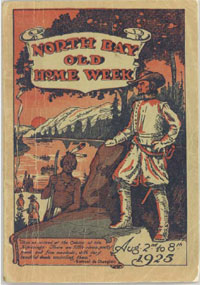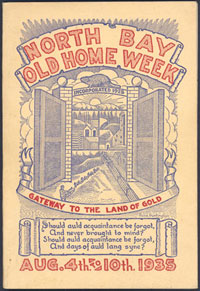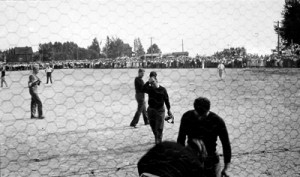The 1925 Souvenir Book
 Old Home Week souvenir books were just that — a souvenir of the event. They provided information about the event and its organization, advertising, and pictures and stories about the place being celebrated. The cover of North Bay’s 1925 souvenir book shows Samuel de Champlain overlooking Lake Nipissing. The fact that Champlain spent the night near North Bay in 1615 is emphasized in the history of North Bay as presented in the souvenir book. Running to 120 pages, the book is a reflection of the prosperity of the period. It included a full list of the Old Home Week committee members, the program for each of the seven days, photographs, advertisements and short historical articles. Overall they present a very positive image of North Bay’s history, growth and progress, which is to be expected.
Old Home Week souvenir books were just that — a souvenir of the event. They provided information about the event and its organization, advertising, and pictures and stories about the place being celebrated. The cover of North Bay’s 1925 souvenir book shows Samuel de Champlain overlooking Lake Nipissing. The fact that Champlain spent the night near North Bay in 1615 is emphasized in the history of North Bay as presented in the souvenir book. Running to 120 pages, the book is a reflection of the prosperity of the period. It included a full list of the Old Home Week committee members, the program for each of the seven days, photographs, advertisements and short historical articles. Overall they present a very positive image of North Bay’s history, growth and progress, which is to be expected.
Information from the 1925 souvenir book has found its way into other sources about North Bay. Kennedy, for example, repeats many of its stories in his history of North Bay. The Trout Mills Women’s Institute also made use of it when putting together their history of Trout Mills. As one of the few sources of the history of the early days, it retains its appeal, but most of the stories cannot be verified. It seems to have played a role in establishing John Ferguson’s role as the founder of North Bay. A list and summary of articles can be found here: Souvenir Book 1925 List Articles.
The 1935 Souvenir Book
 The cover of the English 1935 souvenir book consisted of of an embellished city crest to which was added “North Bay Old Home Week”, with its dates and words from Auld Lang Syne. The lower banner was also changed to read “Gateway to the Land of Gold.” The cover was the winning design submitted in a contest limited to school children under sixteen years of age.
The cover of the English 1935 souvenir book consisted of of an embellished city crest to which was added “North Bay Old Home Week”, with its dates and words from Auld Lang Syne. The lower banner was also changed to read “Gateway to the Land of Gold.” The cover was the winning design submitted in a contest limited to school children under sixteen years of age.
The souvenir book for 1935 was smaller and shorter than that in 1925, reflecting the greater concern for cost. Although it provides pictures of North Bay and a history of its schools and churches, it is not as rich in detail as the 1925 book. It does, however, provide considerable information on the Dionne quintuplets and provides considerable detail on the very recent history of their lives to date along with photos. Souvenir Book 1935 List of Articles
The French Canadian Day Souvenir Book 1935
 This French souvenir book is easy to miss. OHW has been translated to “Ré-Union des Anciens”. This book was issued in French for French Canadian Day by its organizers. It included a full list of the executive of the two clubs sponsoring French-Canadian day, the members of the organizing committee, and a brief history of Le Cercle Canadien-Français de North Bay. Only some of the parishes which participated provided photographs, histories of their parish, and advertisements for the souvenir book: Sainte-Anne de Sudbury, Saint Thomas de Warren, Saint Jean-Baptiste de Verner, Sacré-Coeur de Sturgeon Falls, Saint David de Noelville, Notre-Dame du Lac de Lavigne, Saint-Joseph de Chelmsford, and Saint Vincent de Paul de North Bay. Ads were from businesses owned or managed by members of the French community or at least friendly to it. Lefebvre’s Sport and Tobacco Shop in North Bay, for example, is identified as the location where one can procure French newspapers. The emphasis is quite different than in the English souvenir book. There is no article on the Quints, for example, although one ad does mention its location in relationship to them. French-Canadian Day appears to have been a self-contained ethnic festival within Old Home Week.
This French souvenir book is easy to miss. OHW has been translated to “Ré-Union des Anciens”. This book was issued in French for French Canadian Day by its organizers. It included a full list of the executive of the two clubs sponsoring French-Canadian day, the members of the organizing committee, and a brief history of Le Cercle Canadien-Français de North Bay. Only some of the parishes which participated provided photographs, histories of their parish, and advertisements for the souvenir book: Sainte-Anne de Sudbury, Saint Thomas de Warren, Saint Jean-Baptiste de Verner, Sacré-Coeur de Sturgeon Falls, Saint David de Noelville, Notre-Dame du Lac de Lavigne, Saint-Joseph de Chelmsford, and Saint Vincent de Paul de North Bay. Ads were from businesses owned or managed by members of the French community or at least friendly to it. Lefebvre’s Sport and Tobacco Shop in North Bay, for example, is identified as the location where one can procure French newspapers. The emphasis is quite different than in the English souvenir book. There is no article on the Quints, for example, although one ad does mention its location in relationship to them. French-Canadian Day appears to have been a self-contained ethnic festival within Old Home Week.


 Games which featured Old Timers were also crowd pleasers. As expected, large crowds turned up to watch Old Time baseballers including “Boxcar McDonald”, “Gutty” Lockhart, and “Cap” Weegar in a challenge game against the CPR Ceepees. A photo (left) of a baseball game in 1935 suggests that large crowds watched some of the games.
Games which featured Old Timers were also crowd pleasers. As expected, large crowds turned up to watch Old Time baseballers including “Boxcar McDonald”, “Gutty” Lockhart, and “Cap” Weegar in a challenge game against the CPR Ceepees. A photo (left) of a baseball game in 1935 suggests that large crowds watched some of the games.